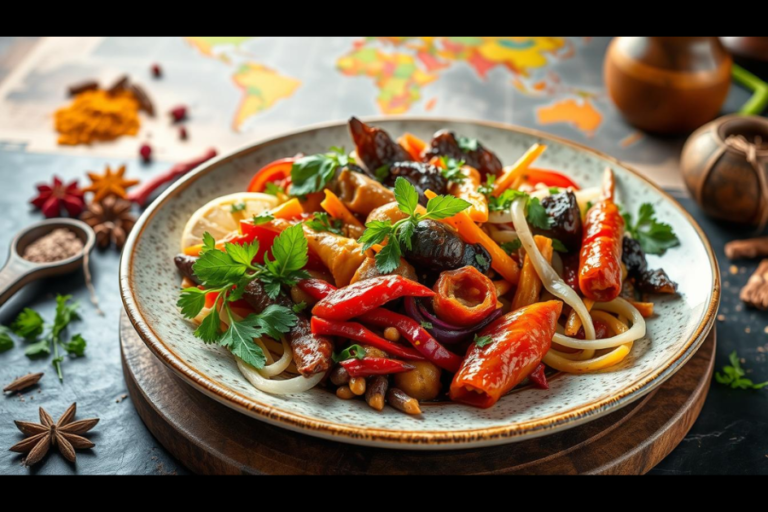Calandrando Explained: What You Need to Know
Mastering Calandrando: A Deep Dive into Sicily’s Culinary Gem
Calandrando embodies the essence of Sicilian culinary heritage, showcasing the island’s rich culture and exceptional gastronomy. To truly excel in preparing this traditional dish, it is essential to understand the time-honored techniques and secrets that Sicilian chefs have refined over generations. This guide offers an in-depth look into these methods, providing you with the knowledge and skills needed to recreate Calandrando in your own kitchen and experience a taste of Sicily.
Discovering Calandrando: The Heart of Sicilian Cuisine
Calandrando is not merely a dish; it represents the soul of Sicilian cooking. Known for its rich, vibrant flavors, it typically includes a blend of fresh seafood, fragrant herbs, and locally sourced vegetables. The secret to its exceptional taste lies in both the high-quality ingredients and the precise preparation techniques that have been cherished and refined over the years.
The Origins of Calandrando: A Culinary Journey Through Sicilian History
Sicilian cuisine is a vibrant tapestry woven from diverse cultural influences, including Greek, Arab, Spanish, and Norman traditions. Calandrando, a dish that captures this rich heritage, began as a simple meal for fishermen but has grown into a cherished favorite among both locals and visitors. Exploring the history of Calandrando not only deepens your appreciation for the dish but also offers valuable insights into the techniques that have shaped its development over time.
Key Ingredients for an Authentic Calandrando
The essence of an authentic Calandrando lies in using high-quality, fresh ingredients. Here’s what you’ll need to create a true Sicilian classic:
- Fresh Seafood: The foundation of Calandrando is its seafood. Choose the freshest options available, including squid, shrimp, mussels, and clams.
- Olive Oil: Sicilian olive oil, prized for its rich and fruity flavor, is essential.
- Tomatoes: Opt for ripe, sun-drenched Sicilian tomatoes, like the Pachino variety, known for their sweetness and minimal acidity.
- Garlic and Onions: These aromatics are crucial for building the dish’s base flavor.
- Herbs: Fresh parsley, basil, and oregano contribute to the dish’s authentic Sicilian taste.
- White Wine: A splash of dry white wine adds depth and complexity.
- Pasta: Traditionally, spaghetti or linguine are used, though you can choose other pasta varieties as well.
- Saffron: While optional, a pinch of saffron imparts a distinct flavor and vibrant color.
Essential Seafood Prep Techniques from Sicilian Chefs
When it comes to Calandrando, Sicilian chefs place great importance on choosing and preparing the freshest seafood. Here’s how to ensure your seafood is top-notch:
- Selection: Look for seafood that has a fresh, oceanic aroma and firm flesh. This indicates it is of high quality.
- Cleaning: Properly clean your seafood before cooking. Scrub mussels and clams to remove any grit and pull off any beards. For squid, remove the innards, peel off the skin, and cut the body into rings.
- Marinating: For added flavor, marinate the seafood in a mixture of olive oil, garlic, and a bit of lemon juice for about 30 minutes. This step enhances the natural flavors and prepares the seafood for cooking.
Building the Flavor Base for Calandrando
The rich, aromatic base is crucial for an authentic Calandrando. Here’s how to create it:
- Sautéing Aromatics: Start by heating olive oil in a large pan over medium heat. Add finely chopped onions and cook until they become translucent.
- Adding Garlic and Herbs: Next, stir in minced garlic and cook until it releases its fragrance. Mix in chopped parsley, basil, and oregano, letting the herbs infuse their flavors.
- Incorporating Tomatoes: Add diced tomatoes to the pan and cook them down until they form a thick, flavorful sauce. Season with salt and pepper to taste, adjusting the seasoning as needed to enhance the overall flavor.
Assembling Your Calandrando
- Cooking the Seafood: Add the cleaned seafood to the tomato base and pour in a splash of white wine. Cook until the seafood is fully done—mussels and clams should open up, and shrimp should turn a vibrant pink.
- Infusing Saffron: If you’re using saffron, steep a pinch in warm water and stir it into the dish. While optional, this adds a distinctive Sicilian flair and a beautiful depth of flavor.
Achieving Pasta Perfection
- Boiling the Pasta: Cook the pasta in a large pot of salted boiling water until it reaches an al dente texture. Before draining, save a cup of the pasta cooking water.
- Combining the Pasta and Seafood: Toss the cooked pasta into the seafood mixture, ensuring it’s well-coated with the sauce. If the sauce seems too thick, gradually add some of the reserved pasta water until you achieve the perfect consistency.
Adding the Final Touches
- Garnishing: To complete your Calandrando, drizzle a bit of olive oil over the dish, sprinkle with freshly chopped parsley, and add a squeeze of lemon juice for a burst of freshness.
- Serving: Serve the dish right away, making sure each plate is heaped with a generous portion of seafood and sauce for the best experience.
Expert Tips from Sicilian Chefs
- Balancing Flavors: According to Sicilian chefs, achieving the right balance of flavors is crucial. The sweetness of tomatoes, the saltiness of seafood, and the acidity of white wine should harmonize. Regularly taste your dish as you cook and adjust the seasoning to achieve the perfect balance.
- Honoring Tradition: While it might be tempting to add modern twists, Sicilian chefs recommend staying true to traditional methods and ingredients. This approach maintains the authenticity of Calandrando and ensures the dish remains true to its roots.
- Focusing on Presentation: The visual appeal of Calandrando is just as important as its taste. Arrange the seafood attractively on the pasta and garnish it thoughtfully to make the dish visually appealing.
- Pairing with Wine: Enhance your Calandrando experience by pairing it with a Sicilian wine. A crisp Grillo or a dry Chardonnay complements the seafood beautifully, adding an extra layer of enjoyment to your meal.
Summary:
Calandrando is a quintessential Sicilian dish that exemplifies the island’s rich culinary heritage. This guide provides a detailed exploration of Calandrando, covering its historical roots, essential ingredients, and expert preparation techniques. The dish, which traditionally features fresh seafood, tomatoes, aromatic herbs, and pasta, is celebrated for its robust flavors and vibrant presentation. Key steps include selecting the freshest seafood, creating a flavorful base with garlic, herbs, and tomatoes, and achieving the perfect pasta consistency. Garnishing with olive oil, parsley, and lemon juice adds the finishing touch. Sicilian chefs emphasize balancing flavors, respecting traditional methods, and focusing on presentation to elevate Calandrando. Pairing the dish with a Sicilian wine, such as Grillo or Chardonnay, enhances the overall dining experience.
FAQs:
1. What is Calandrando?
Calandrando is a traditional Sicilian dish that combines fresh seafood with tomatoes, aromatic herbs, and pasta. It is known for its rich flavors and vibrant presentation, reflecting the essence of Sicilian cuisine.
2. What are the key ingredients for making Calandrando?
The essential ingredients for Calandrando include fresh seafood (such as squid, shrimp, mussels, and clams), Sicilian olive oil, ripe tomatoes, garlic, onions, fresh herbs (parsley, basil, oregano), white wine, pasta (spaghetti or linguine), and optionally saffron.
3. How do you prepare the seafood for Calandrando?
Select fresh seafood with a pleasant aroma and firm texture. Clean the seafood thoroughly—scrub mussels and clams, remove innards and skin from squid, and cut it into rings. Marinate the seafood in olive oil, garlic, and lemon juice for added flavor.
4. What is the best way to build the flavor base for Calandrando?
Start by sautéing finely chopped onions in olive oil until translucent. Add minced garlic and cook until fragrant. Incorporate chopped herbs, then add diced tomatoes and cook until they form a thick sauce. Season with salt and pepper to taste.
5. How do you achieve pasta perfection for Calandrando?
Cook the pasta in salted boiling water until al dente. Reserve a cup of the pasta cooking water before draining. Toss the pasta with the seafood mixture, adding reserved pasta water as needed to achieve the desired sauce consistency.
Get the inside scoop on fitness innovations and lifestyle hacks at Sweatlar.com.






